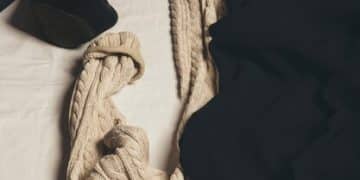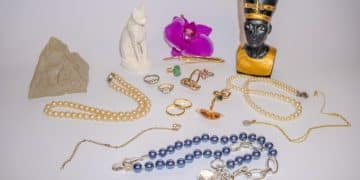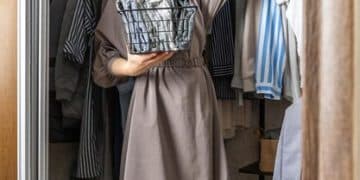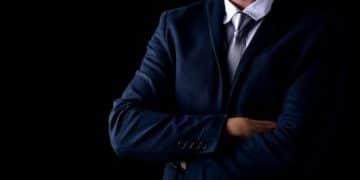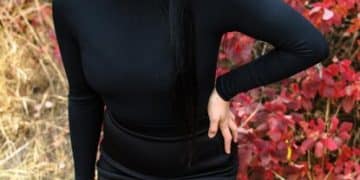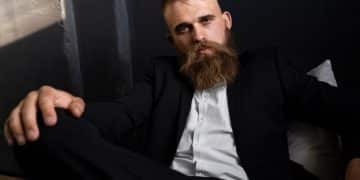The Modern Gentleman’s Style Handbook: Essential Wardrobe Staples for Every Occasion
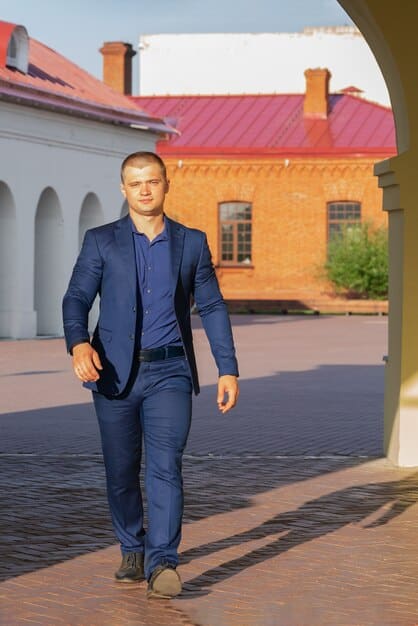
The modern gentleman’s style handbook outlines a curated selection of essential wardrobe staples, offering foundational pieces that ensure versatility, elegance, and appropriateness for any social or professional occasion, empowering men to build a sophisticated and adaptable personal style.
In a world where first impressions often shape opportunities, establishing a distinguished personal style is not merely an act of vanity but a strategic advantage. The Modern Gentleman’s Style Handbook: Essential Wardrobe Staples for Every Occasion serves as your definitive guide to cultivating a wardrobe that transcends fleeting trends, offering timeless elegance and versatility.
Understanding the Modern Gentleman’s Aesthetic
The concept of a “gentleman” has evolved, but its core tenets—refinement, respect, and a keen eye for detail—remain central. For the modern man, this translates into an aesthetic that balances classic sophistication with contemporary functionality. It’s about coherence and intent, ensuring every piece serves a purpose and contributes to a polished overall image.
The foundation of this aesthetic rests on quality over quantity. Instead of chasing every new fashion fad, the savvy gentleman invests in well-made garments that offer longevity and enduring style. This approach not only builds a more sustainable wardrobe but also ensures that each item can be mixed and matched effortlessly, maximizing versatility.
The Philosophy of Timelessness
Timelessness in style means choosing pieces that will remain relevant for years, even decades. This often involves sticking to classic silhouettes, neutral color palettes, and high-quality fabrics. Fashion trends come and go, but true style endures. A timeless wardrobe allows a man to always look appropriate and sharp, regardless of the current season’s dictates.
- Neutral Color Palette: Focus on foundational colors like navy, charcoal, black, white, and various shades of gray and brown.
- Classic Silhouettes: Opt for traditional cuts in suits, shirts, and trousers that flatter most body types.
- High-Quality Fabrics: Invest in natural fibers such as wool, cotton, linen, cashmere, and silk for comfort, durability, and drape.
- Versatility: Each item should ideally be capable of being dressed up or down, allowing for multiple outfit combinations.
Embracing a minimalist mindset can also contribute significantly to the modern gentleman’s wardrobe. A smaller, well-curated collection of high-quality items eliminates decision fatigue and always provides a suitable option. It’s about making conscious choices that reflect personal values and professional aspirations, rather than succumbing to consumerist pressures.
Ultimately, the modern gentleman’s aesthetic is an extension of his character: confident, discerning, and composed. It’s a subtle yet powerful form of communication, signaling professionalism, self-awareness, and an appreciation for lasting value. Building such a wardrobe is an investment in oneself, yielding dividends in confidence and perception.
The Indispensable Suit Collection
No discussion of a gentleman’s wardrobe is complete without diving into the world of suits. Far from being a mere uniform, a well-tailored suit is a powerful sartorial tool, conveying authority, elegance, and attention to detail. For the modern man, a versatile suit collection forms the bedrock of his formal and business attire.
Starting with the basics, two suits are non-negotiable: a navy suit and a charcoal gray suit. These two colors are incredibly versatile, suitable for almost any formal or semi-formal occasion, from business meetings to weddings. They serve as excellent canvases, allowing for diverse shirt and tie combinations.
Navy and Charcoal: Your Foundation
The
navy suit
is perhaps the most versatile item in a man’s wardrobe. Its deep hue is sophisticated and approachable, making it suitable for both daytime and evening events. Paired with a crisp white shirt and a silk tie, it exudes professional authority, while a lighter blue shirt and an open collar can transition it to a more relaxed, smart-casual look.
- Business Meetings: Pair with a white or light blue shirt and a solid or subtly patterned tie.
- Weddings/Formal Events: Opt for a spread collar shirt, a luxurious tie, and polished dress shoes.
- Smart Casual: Wear the jacket with chinos or dark denim, or the trousers with a knit polo.
The
charcoal gray suit
offers a similar level of versatility but with a slightly different character. It’s inherently more formal than navy, making it an excellent choice for significant business presentations or more somber occasions. Its neutral tone provides a sophisticated backdrop for a wide array of shirt and tie colors, allowing for personal expression without sacrificing professionalism.
When selecting these foundational suits, attention to fit is paramount. A bespoke or made-to-measure suit will always provide the best fit, but off-the-rack options can be tailored to achieve a refined silhouette. The shoulders should fit precisely, the jacket length should cover the seat, and the trousers should have a clean break over the shoes.
Beyond the Basics: Expanding Your Repertoire
Once you have the navy and charcoal covered, consider adding a black suit, primarily for very formal evening events, funerals, or specific business environments requiring utmost formality. For more expressive occasions, a subtly patterned suit, such as a pinstripe or faint plaid, can add distinctiveness without being overly ostentatious. Lighter gray or tan suits are excellent for warmer months or less formal daytime events.
Remember that a suit is not just a single garment but a collection of pieces. The jacket and trousers can often be worn separately, expanding your wardrobe’s utility. A suit jacket can double as a sport coat, paired with different trousers for a smart-casual ensemble, showcasing the true value of investing in high-quality, adaptable pieces.
Essential Shirts and Outerwear
Beneath the powerful silhouette of a tailored suit or as standalone statements for smart-casual affairs, shirts form the backbone of a gentleman’s daily attire. Complementing these are carefully chosen outerwear pieces that not only provide protection from the elements but also elevate an ensemble’s overall sophistication.
At the core of an effective shirt collection are a few crisp white dress shirts. Their pristine simplicity makes them unequivocally versatile, suitable for formal business wear, evening events, or even dressing up smart-casual outfits. Following closely are light blue dress shirts, offering a slightly more relaxed yet equally professional alternative. Both colors pair effortlessly with virtually any tie and suit combination, making them indispensable staples.
The Foundation of Shirts
Beyond the solid whites and blues, consider incorporating shirts with subtle patterns. A fine stripe or a delicate check can add visual interest without being distracting, allowing for nuanced expression within conservative environments. It’s crucial that these patterns remain understated, complementing rather than overpowering the rest of the outfit. Fabric quality is key; opt for breathable cotton weaves like poplin, twill, or oxford, which offer both comfort and durability.
- White Dress Shirts: Absolute must-haves for formal and business occasions.
- Light Blue Dress Shirts: Versatile for both formal and smart-casual settings.
- Subtle Patterned Shirts: Add character with thin stripes, gingham, or small checks.
- Oxford Cloth Button-Down (OCBD): A casual staple that can also be dressed up with a tie.
For more relaxed settings, quality casual shirts are essential. A well-fitting denim shirt, a classic chambray, or a range of solid-colored knit polo shirts provide comfortable yet stylish options. These can be worn untucked with chinos or dressed up with tailored trousers, demonstrating the breadth of a modern gentleman’s sartorial choices.
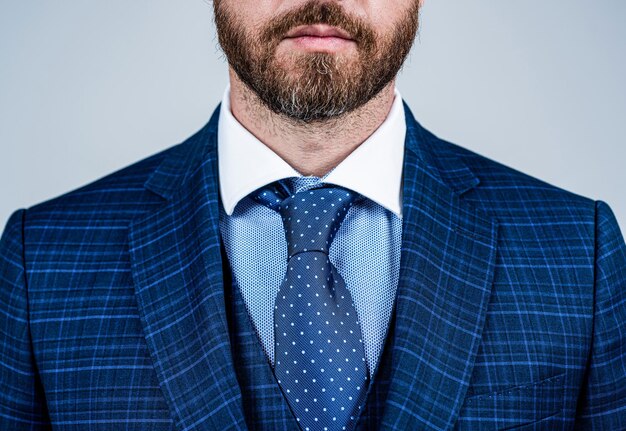
Outerwear for Every Season
Outerwear is where practicality meets panache. A classic trench coat is an iconic piece, offering protection from rain while exuding timeless sophistication. Its versatile design means it can be thrown over a suit or paired with smart casuals. For colder weather, a high-quality wool overcoat in navy, charcoal, or camel provides essential warmth and an elegant silhouette.
For more temperate conditions, a well-structured blazer or sport coat is invaluable. These can instantly elevate a casual outfit, providing a sharp layer over a t-shirt, polo, or casual shirt. Consider a versatile navy blazer with brass buttons for a classic look, or a textured tweed or flannel sport coat for added character and warmth.
Finally, a lightweight jacket, such as a classic bomber or a field jacket, serves a practical purpose for transitional weather and more relaxed outings. The key across all outerwear selections is quality construction and a flattering fit, ensuring that even your outer layers contribute positively to your overall appearance.
Trousers and Denim: Bottom Half Essentials
While often overshadowed by their upper-body counterparts, trousers and denim play an equally critical role in defining a gentleman’s style. The right bottoms can elevate an outfit, ensure comfort, and provide the versatility needed to navigate various social and professional scenarios.
Start with a core collection of well-fitting tailored trousers. Essential colors include charcoal gray, navy, and perhaps a versatile tan or olive. These should be crafted from quality wool or wool blends, ensuring a sophisticated drape and durability. Flat-front styles generally offer a cleaner, more modern silhouette compared to pleated options.
Building Your Foundation of Trousers
The fit of your trousers is paramount. They should sit comfortably at your natural waist, without being too tight or too loose. The length is crucial: aim for a slight break or no break at all, depending on your personal preference and the style of shoe you plan to wear. A clean, streamlined look conveys attention to detail.
- Wool Trousers: Essential in charcoal, navy, and possibly a lighter gray or tan for versatility.
- Chinos: A go-to for smart-casual wear, offering comfort without sacrificing style; include colors like khaki, navy, and olive green.
- Dress Cords: A stylish alternative for cooler weather, providing texture and a touch of sartorial flair.
Beyond tailored trousers, a selection of quality chinos is indispensable for smart-casual and business-casual settings. Khaki, navy, and olive green are excellent starting points, offering versatility with casual shirts, knitwear, and sport coats. Chinos bridge the gap between formal trousers and casual denim, allowing for a polished yet relaxed appearance.
The fabric and construction of chinos matter. Look for sturdy cotton twill that holds its shape well and offers a comfortable wear. While typically worn uncreased, a quick press can elevate their appearance for occasions that demand a touch more formality.
The Ubiquitous Denim
Denim, once synonymous with rugged workwear, has successfully cemented its place in the modern gentleman’s wardrobe, albeit with specific considerations. The key is to select dark-wash, straight-leg or slim-fit jeans that are free from excessive distressing or embellishments. These are the most adaptable for dressing up or down.
A pair of dark indigo or black denim jeans can be effortlessly styled with a crisp dress shirt, a tailored blazer, and loafers for a sophisticated casual look. They can also be paired with a simple t-shirt and sneakers for a more relaxed weekend ensemble. The versatility of quality, well-fitting denim makes it an essential part of any comprehensive wardrobe.
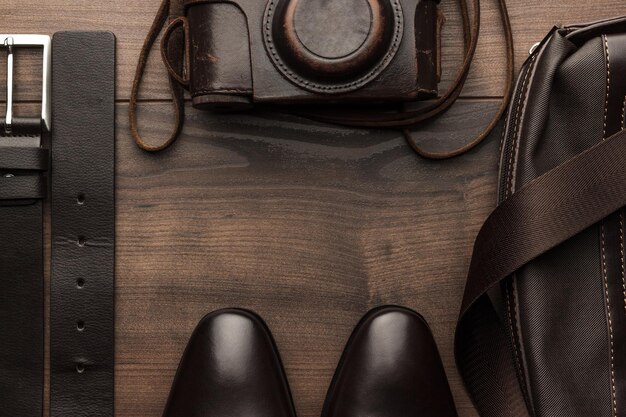
When curating your denim collection, invest in one or two pairs of premium quality. Pay attention to the fabric’s feel and recovery, ensuring it maintains its shape throughout the day. Like all other garments, fit reigns supreme; avoid overly baggy or excessively tight styles, opting for a clean line that complements your silhouette.
Footwear and Accessories: The Finishing Touches
No outfit is complete without the right footwear and accessories. These elements are not mere afterthoughts; they are crucial components that can elevate an ensemble, reflecting a gentleman’s discerning taste and attention to detail. Investing in quality pieces here yields significant sartorial dividends.
For footwear, versatility and durability are key. A pair of classic black leather oxfords is the cornerstone of any formal wardrobe. Ideal for business meetings, interviews, and black-tie events, their sleek design pairs perfectly with navy, charcoal, and black suits. Equally important are dark brown leather Oxfords or Derbies, offering a slightly less formal but equally sophisticated option that complements a broader range of suit and casual colors.
Building Your Shoe Collection
- Black Leather Oxfords: Essential for formal business and black-tie events.
- Dark Brown Leather Derbies/Oxfords: Versatile for business-casual to formal; great with navy and grey.
- Brown Loafers: Perfect for smart-casual, adding a refined touch to chinos or casual trousers.
- White Minimalist Sneakers: A clean, modern choice for elevated casual looks.
- Chelsea Boots: Stylish and practical for urban and smart-casual wear, especially in cooler months.
Beyond the formal, a pair of dark brown or burgundy loafers offers a sophisticated smart-casual choice, ideal for pairing with chinos, tailored trousers, or even well-fitted dark denim. For truly casual settings, clean, minimalist white leather sneakers are a contemporary essential, offering comfort and style when paired with jeans or shorts.
Consider also a pair of dress boots, such as Chelsea boots or chukkas, especially for cooler weather. These add a rugged yet refined element, pairing well with denim, corduroys, and even some smart-casual suit trousers. Always ensure your shoes are well-maintained, polished, and free of scuffs, as scuffed shoes can undermine an otherwise impeccable outfit.
The Power of Accessories
Accessories are the details that define a gentleman’s style. Start with a selection of high-quality ties: silk solids in navy, burgundy, and grey are foundational, complemented by subtle patterns like stripes or grenadine weaves. A few pocket squares—white linen for formal, and patterned silk for adding flair—can instantly elevate a blazer or suit jacket.
Belts should always match your shoes in color and approximate formality. A black leather belt for black shoes, and a brown leather belt for brown shoes, are non-negotiable. Quality watches, from a classic dress watch for formal occasions to a versatile everyday timepiece, are a subtle statement of sophistication.
Additional accessories like cufflinks, tie clips, and sleek leather briefcases or messenger bags serve both functional and aesthetic purposes. These items should be chosen for their quality and timeless design, rather than following fleeting trends. They underscore an overall sense of polish and professionalism, reinforcing the image of a well-put-together modern gentleman.
Curating Your Wardrobe: Beyond the Staples
Having established the foundational wardrobe staples, the next step for the modern gentleman is to refine and personalize his collection. This involves understanding how to integrate seasonal pieces, incorporate subtle trends, and maintain the integrity of a high-quality, versatile wardrobe. It’s about moving beyond simply acquiring items to thoughtfully curating a personal style.
Seasonal flexibility is paramount. While your core pieces provide year-round utility, consider adding lighter fabrics like linen, seersucker, or fresco wool for warmer months. A linen blazer paired with cotton trousers or a seersucker suit can provide comfort and style in summer while maintaining a polished appearance. Similarly, heavier fabrics like tweed, flannel, and cashmere are ideal for colder weather, offering warmth and texture.
Seasonal Adaptations and Strategic Additions
This does not mean buying a completely new wardrobe each season. Instead, it’s about strategic additions that complement your existing staples. For instance, swapping a heavy wool tie for a linen or knit tie in spring, or replacing a dress shirt with a lightweight knit polo for a business-casual summer look. These subtle changes adapt your style to the climate without requiring a complete overhaul.
- Summer Fabrics: Linen, seersucker, lightweight cottons for suits, shirts, and trousers.
- Winter Fabrics: Flannel, tweed, cashmere, heavy wools for warmth and texture.
- Layering Pieces: V-neck sweaters, cardigans, and gilets in fine merino wool or cashmere for added warmth and versatility.
Incorporating trends should be done judiciously. The modern gentleman understands that true style is enduring, not fleeting. Instead of adopting every passing fad, identify trends that align with your personal aesthetic and can seamlessly integrate with your timeless pieces. This might involve a particular color palette, a subtle pattern, or a specific accessory, rather than a wholesale adoption of a new silhouette.
A good strategy is to experiment with trends through accessories or less expensive items that can be easily replaced. A patterned pocket square, a contemporary pair of eyeglasses, or a unique pair of socks can introduce a current sensibility without compromising the classic foundation of your wardrobe. This allows for personal expression while maintaining an overall sophisticated image.
Maintaining and Investing in Your Style
Building a sophisticated wardrobe is an ongoing endeavor that extends beyond merely acquiring clothes. It involves a commitment to maintenance, understanding investment pieces, and continuously refining one’s personal style. For the modern gentleman, these practices ensure longevity and sustained elegance.
Proper garment care is paramount. Regular dry cleaning for suits, appropriate washing and ironing for shirts, and meticulous storage can significantly extend the life of your clothing. Investing in quality hangers, shoe trees, and garment bags protects your investments and keeps them looking their best. A well-maintained wardrobe not only preserves its appearance but also reduces the need for frequent replacements.
The Value of Proper Care
Beyond routine care, minor repairs should be addressed promptly. A loose button, a frayed hem, or a small tear can detract from an otherwise polished appearance. Learning basic sewing skills or establishing a relationship with a trusted tailor for more significant alterations ensures your clothes always fit perfectly and are in pristine condition. This attention to detail speaks volumes about one’s overall meticulousness.
- Regular Cleaning: Follow care labels closely for all garments.
- Proper Storage: Use quality hangers for suits and shirts, shoe trees for footwear.
- Timely Repairs: Address minor damages promptly to prevent further deterioration.
- Professional Tailoring: Ensure every garment fits perfectly, enhancing overall appearance.
Investing in your wardrobe means prioritizing quality over quantity. While some might view high-quality garments as expensive, their longevity, superior drape, and timeless appeal often make them more cost-effective in the long run. A well-constructed pair of leather shoes, for example, can last decades with proper care, whereas cheaper alternatives might need frequent replacement.
This investment philosophy also extends to tailoring. An off-the-rack suit or pair of trousers can be transformed into a custom-fit garment with professional alterations. The difference a perfect fit makes to a garment’s appearance is profound, instantly elevating its perceived quality and your overall presence.
Continuous Refinement
Finally, personal style is not static; it evolves with experience, age, and changing personal preferences. Continuously assessing your wardrobe, identifying what truly works for you, and being open to subtle changes ensures your style remains authentic and reflective of who you are. This might involve experimenting with new colors, textures, or even different clothing categories as your needs and tastes change.
Seek inspiration from various sources—fashion editorials, well-dressed individuals, or even historical figures—but always adapt it to your own context. The goal is to build a wardrobe that feels like a natural extension of yourself, allowing you to dress with confidence and ease for any occasion life presents.
| Key Item | Purpose & Versatility |
|---|---|
| 👔 Navy/Charcoal Suit | The foundation of formal and business attire, suitable for most professional and social events. |
| 👕 White/Light Blue Dress Shirts | Versatile staples for dressing up or down, pairing well with suits, blazers, and trousers. |
| 👖 Tailored Trousers & Dark Denim | Essential bottoms for smart-casual to sophisticated casual looks, offering comfort and style. |
| 👞 Polished Dress Shoes | Critical finishing touch to any outfit, from formal Oxfords to versatile loafers or minimalist sneakers. |
Frequently Asked Questions About Gentleman’s Style
The most important aspect is fit. Regardless of the garment’s brand or cost, if it doesn’t fit well, it won’t look good. A well-tailored piece elevates your appearance significantly, conveying confidence and attention to detail. Investing in tailoring is often more impactful than buying expensive new clothes.
A modern gentleman generally needs at least two versatile suits: a navy one and a charcoal gray one. These two colors cover most formal and business occasions. Depending on lifestyle, adding a lighter grey or tan suit for summer, and potentially a black suit for very formal events, can enhance versatility.
Beyond dress shoes, essential casual footwear includes versatile brown loafers, which bridge the gap between casual and smart-casual. Clean, minimalist white leather sneakers are also a must for elevated casual looks with jeans or chinos. Chelsea boots or chukkas can add a refined touch for cooler weather or smart-casual outings.
Yes, as a general rule, a gentleman should always strive to match his belt to his shoes in color and leather type. This creates a cohesive and polished look. For example, black dress shoes should be paired with a black leather belt, and brown shoes with a brown leather belt. This detail significantly impacts overall presentation.
Fabric quality is incredibly important. High-quality natural fibers like wool, cotton, linen, and cashmere offer better drape, breathability, and durability. They maintain their shape and appearance longer, making them a wise investment. Superior fabrics not only feel better but also convey an undeniable sense of luxury and refinement.
Conclusion
Curating The Modern Gentleman’s Style Handbook: Essential Wardrobe Staples for Every Occasion is about more than just buying clothes; it’s about building a foundational collection that empowers confidence, versatility, and enduring elegance. By prioritizing quality over quantity, investing in timeless pieces, and paying meticulous attention to fit and maintenance, any man can cultivate a wardrobe that speaks volumes about his discernment and professionalism. Ultimately, true style resides not just in what you wear, but in how you wear it, reflecting an authentic and composed self.
